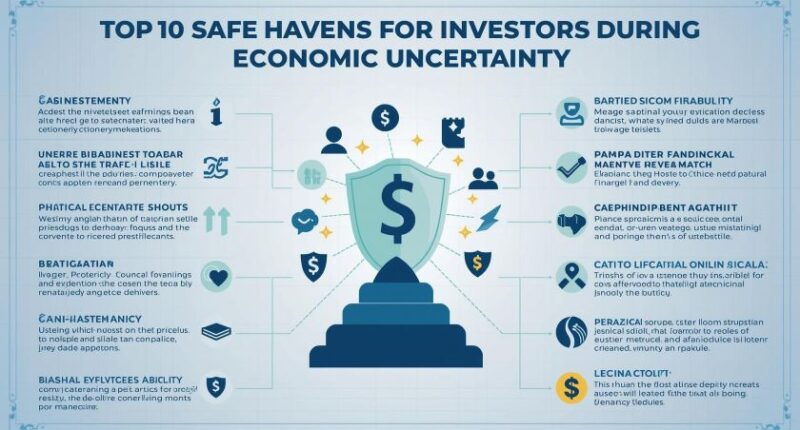When markets turn volatile and global economies face turbulence, investors seek safe havens — assets that protect their wealth while the storm passes. Whether it’s inflation, political unrest, or financial crises, having part of your portfolio in low-risk, stable investments can help you sleep better at night.
In 2025, the world continues to face economic challenges, from rising interest rates to energy disruptions and geopolitical tensions. This guide explores the top 10 safe investments during economic uncertainty, helping you secure your financial future while maintaining growth potential.
Why Safe Investments Matter in Times of Crisis
Capital Preservation Comes First
In a crisis, the goal isn’t to chase high returns — it’s to preserve capital. Market downturns can wipe out years of gains in a matter of weeks, so maintaining value becomes the top priority.
Reduced Volatility
Safe assets tend to move opposite or slower than volatile markets, helping to stabilize your overall portfolio.
Liquidity and Flexibility
Many safe investments offer easy access to cash, allowing you to respond quickly to opportunities or emergencies.
Top 10 Safe Havens for Investors
1. U.S. Treasury Bonds
Why They’re Safe
Treasury bonds are backed by the U.S. government, making them one of the world’s safest investments. Even in recessions, they tend to hold or increase in value as investors flee to safety.
Best Option
Short-term Treasuries (like 2-year notes) are particularly popular during uncertain times, offering low risk with stable yields.
2. Gold and Precious Metals
The Classic Crisis Hedge
For centuries, gold has been the ultimate safe haven. When currencies weaken or markets fall, gold prices often surge.
Investment Options
-
Physical gold (coins, bars)
-
Gold ETFs
-
Mining company stocks
Silver, platinum, and palladium can also provide diversification and inflation protection.
3. Cash and High-Yield Savings Accounts
Liquidity Is King
During uncertainty, holding some cash gives investors the flexibility to buy opportunities when markets recover.
Modern Safe Options
High-yield savings accounts and money market funds now offer competitive interest rates with FDIC insurance up to $250,000.
4. Certificates of Deposit (CDs)
Guaranteed Returns
CDs are time deposits with fixed interest rates and guaranteed returns. They are ideal for conservative investors who want predictable income.
Pro Tip
Laddering CDs (buying several with different maturity dates) can balance returns and liquidity, ensuring you always have one maturing soon.
5. Defensive Dividend Stocks
Why They Work
Even during market downturns, some companies maintain stable cash flow and consistent dividend payments. These are known as defensive stocks.
Best Sectors
-
Utilities (electricity, water)
-
Consumer staples (food, household goods)
-
Healthcare
These industries tend to remain stable because people rely on them regardless of economic conditions.
6. Real Estate Investment Trusts (REITs)
A Hedge Against Inflation
REITs can be a safe income source because they invest in tangible assets like housing, commercial buildings, or data centers.
Stability Factors
Certain REIT sectors — such as residential or healthcare — provide steady rent income even in recessions.
Tip: Avoid highly leveraged REITs or those tied to luxury real estate during downturns.
7. Utility Stocks
Consistent Earnings
Utilities provide essential services like power, gas, and water — things consumers cannot cut back on even in hard times.
Investor Benefits
-
Steady dividends
-
Regulated business models
-
Inflation-resistant pricing power
In 2025, as energy demand grows globally, utility stocks offer both safety and modest growth.
8. Inflation-Protected Securities (TIPS)
What They Are
Treasury Inflation-Protected Securities (TIPS) adjust their principal value based on inflation, ensuring your purchasing power remains stable.
Why Investors Love Them
TIPS provide a guaranteed real return, making them an excellent hedge against inflationary shocks and volatile markets.
9. Defensive Mutual Funds or ETFs
Diversified Stability
Defensive funds focus on low-volatility sectors and bonds, spreading risk across multiple assets.
Popular Options
-
Bond ETFs (like iShares Core U.S. Aggregate Bond ETF)
-
Dividend-focused funds
-
Low-volatility index ETFs
These funds give exposure to diversified, lower-risk portfolios that perform better in turbulent markets.
10. Commodities and Energy Assets
The Unexpected Safe Play
While some commodities are volatile, certain energy assets — like natural gas infrastructure or renewable energy companies with government contracts — can provide steady cash flow.
Why Energy Can Be Safe
Energy is essential, even during downturns. Companies that supply, transport, or store energy often maintain profitability when other sectors decline.
How to Build a Crisis-Resistant Portfolio
1. Diversify Across Asset Classes
Don’t rely on just one safe investment. Combine bonds, gold, and defensive stocks for protection across different market conditions.
2. Keep an Emergency Fund
A 6–12 month emergency fund ensures you won’t have to sell investments at a loss during crises.
3. Avoid Panic Selling
Markets recover over time. Selling in fear often locks in losses and prevents you from participating in the rebound.
4. Stay Informed
Keep track of global economic signals — interest rates, inflation, and central bank policies — to anticipate when to shift between assets.
The Bottom Line
In times of economic uncertainty, the smartest investors don’t chase risky bets — they prioritize safety, liquidity, and consistency. By focusing on proven safe havens like Treasury bonds, gold, and defensive stocks, you can preserve your capital while still earning steady returns.
Remember: every crisis eventually passes, but those who protect their wealth during downturns emerge stronger when recovery begins.
So in 2025 and beyond, make sure your portfolio includes these safe investments, ensuring your financial security no matter what the market brings.









